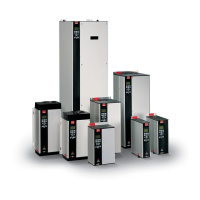VLT
®
5000 Series
pulse ref.
A signal transmitted to the digital inputs
(terminal 17 or 29).
b
inary ref.
A signal transmitted to the serial communication port.
R
ef
MIN
The smallest value which the reference signal
may have. Set in parameter 204.
R
ef
MAX
The maximum value which the reference signal
may have. Set in parameter 205.
Miscellaneous:
E
LCB:
Earth Leakage Circuit Breaker.
l
sb:
Least significant bit.
Used in serial communication.
m
sb
Most significant bit.
Used in serial communication.
P
ID:
The PID regulator maintains the desired speed
(pressure, temperature, etc.) by adjusting the output
frequency to match the varying load.
T
rip:
A state which occurs in different situations, e.g.
if the frequency converter is subjected to an
overtemperature. A trip can be cancelled by pressing
reset or, in some cases, automatically.
T
rip locked:
A state which occurs in different situations, e.g. if the
frequency converter is subject to an overtemperature.
A locked trip can be cancelled by cutting off mains
and restarting the frequency converter.
I
nitialising:
If initialising is carried out, the frequency converter
returns to the factory setting.
S
etup:
There are four Setups, in which it is possible to
save parameter settings. It is possible to change
between the four parameter Setups and to edit one
Setup, while another Setup is active.
L
CP:
The control panel, which makes up a complete
interface for control and programming of VLT 5000
Series. The control panel is detachable and may,
as an alternative, be installed up to 3 metres away
from the frequency converter, i.e. in a front panel,
by means of the installation kit option.
V
VC
plus
If compared with standard voltage/frequency ratio
control, VVC
plus
improves the dynamics and the
stability, both when the speed reference is changed
and in relation to the load torque.
S
lip compensation:
Normally, the motor speed will be affected by the
load, but this load dependence is unwanted. The
frequency converter compensates for the slip by
giving the frequency a supplement that follows
the measured effective current.
T
hermistor:
A temperature-dependent resistor placed where
the temperature is to be monitored (frequency
converterormotor).
A
nalogue inputs:
The analogue inputs can be used for controlling
various functions of the frequency converter.
There are two types of analogue inputs:
Current input, 0-20 mA
Voltage input, 0-10 V DC.
A
nalogue outputs:
There are two analogue outputs, which are able to
supply a signal of 0-20 mA, 4-20 mA or a digital signal.
D
igital inputs:
The digital inputs can be used for controlling various
functions of the frequency converter.
D
igital outputs:
There are four digital outputs, two of which activate
a relay switch. The outputs are able to supply
a24VDC(max. 40mA)signal.
B
rake resistor:
The brake resistor is a module capable of
absorbing the brake power that is generated in
regenerative braking. This regenerative braking
power increases the intermediate circuit voltage
and a brake chopper ensures that the power is
transmitted to the brake resistor.
MG.51.A9.02 - VLT is a registered Danfoss trademark
176
